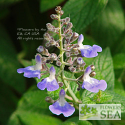 | Mexico is a land of almost unimaginable plant diversity, including the highest concentration of native sages (Salvia spp.) in the world. It is home to nearly a third of the approximately 900 Salvia species worldwide. The rich biodiversity of Mexico is due, in part, to its many types of climates from the deserts of Northern Mexico and Baja to the mountainous cloud forests at its southern boundary with Guatemala. Salvia is a member of the mint family (Lamiaceae). Although Lamiaceae is only the eighth largest plant family in Mexico, Salvia is one of the country's largest genuses. It is a genus with species fit for many climates, which is exactly what Mexico has. Consequently, Mexican sages grow beautifully in many parts of America. Some are even cold hardy to USDA Zone 5. One factor that causes Mexico's climate to vary so much despite its closeness to the equator is the country's up-and-down geography; it is a land of many mountains and numerous changes in elevation. Some peaks -- such as the volcano Pico de Orizaba near the port of Veracruz in southeastern Mexico -- are topped with snow and glaciers year round even when their lower slopes are hot in summer. Mexican native species range from drought-tolerant sages that grow best if given little water and lots of sunlight to ones that can take heat, but prefer partial shade and plentiful moisture. They tend to be long-blooming plants with a rainbow of flower colors. Many Mexican sages are fragrant. On warm summer days, they lend a heady perfume to the landscape when planted near home entryways or as borders along walkways. They include low-growing groundcovers as well as plants so tall, wide and floriferous that a group planting forms a dramatic privacy screen. Some of these plants are the source of age-old folk remedies and the focus of current medical research; their potential health benefits are modern day treasure. And here is one more thing that is golden about Mexican native sages: these lovely additions to home gardens require little fuss. |
(Pine Mountain Sage) Small but numerous, violet and deep purple flowers surrounded by pink bracts are sprinkled throughout this well-branched,shrubby sage like confections. This is one of the showiest Salvias we grow.
(Sinaloan Blue Sage) It's difficult to say which trait is more attractive about this sage -- the airy spikes of deep, true blue flowers or the fascinating spear-shaped foliage that varies from deep green to purple, forming a tidy mat.
(Smith College Mystery Sage) This mysterious species came to us via Smith College in Northampton, Massachusetts. We refer to it as "Mystery Sage" as the origins of this fine plant are unclear.
(Thryce Flowered Sage) A wonderfly floriferous shrubby species from the mountains of Jalisco, Mexico. The individual flowers are small, but so numerous as to be uncountable. The textured foliage makes this a stand out in the garden.
(Blue Bush Sage) Furry, large and heavily textured, the mid-green leaves of Salvia urica contrast attractively with its violet-blue flowers that bloom spring into summer.
(Grape Leaf Sage) Tall spikes of intensely blue flowers bloom summer to fall and emerge in profusion from handsome, furry foliage. The leaves are grape green on top and purplish on the bottom. This water-loving sage grows rapidly into a spreading mound.
(Pink & White Wagner's Sage) Instead of pink, leaf-life bracts, this variety of Wagner's Sage has white bracts surrounding the hot pink flowers. It blooms from November to March on our coastal Northern California farm where it feeds Anna's hummingbirds all winter long.
(Windwalker® Royal Red Salvia) Salvia darcyi x S. microphylla 'PWIN03S' is one of the top 2015 plants for USDA Cold Hardiness Zone 5 selected by Colorado's Plant Select®, a nonprofit organization that focuses on promoting plants for low-water gardens.
(Elk Blue Moon III Jame Sage) Dark calyxes cup dusky blue flowers that age to lavender and rise up from the veined, mid-green foliage of Salvia x ‘Elk Blue Moon III’.
(Elk Morning Sun Jame Sage) Kelly green and black calyxes support the long blooming, creamy white and pale pink flowers of Salvia x ‘Elk Morning Sun’. A waterwise sage, it likes average watering but resists drought.
(Elk Raspberry Moose Sage) The deep raspberry flowers of this Salvia x Jamensis look good enough to eat, like spoonfuls of a silky, mouthwatering mousse dessert. Yet the 'moose' in its name isn't a misspelling. It refers to flowers that are larger than normal for a Jame Sage.
(John Whittlesey Sage) Hardy, vigorous and long blooming, John Whittlesey Sage is a hybrid of D'Arcy's Sage (Salvia darcyi) -- a native of Mexico -- and Mountain Sage (S. microphylla), which is native to the American Southwest and Mexico.
(Mulberry Jam Roseleaf Sage) Magenta flower buds burst into fuzzy, hot pink blossoms in this hybrid sage from the gardens of Betsy Clebsch, author of The New Book of Salvias.
(Purple Stem Sage) Deep purple stems and cobalt blue flowers with pronounced white beelines and dusky gray calyxes cause this sage to command attention.
(Waverly Sage) A pale pink to lavender blush adds delicate color to the white flowers of Waverly Sage, which are supported by plum-colored calyxes. Its mid-green leaves are lance shaped and veined.
(Dyson's Orangy Pink Hybrid Jame Sage) Many Salvia x jamensis hybrids remind gardeners of sunrise, such as Dyson's Orangy Pink. Light green calyxes faintly striped with red cup its luminous pale salmon pink blossoms with creamy throats.
(Tangerine Ballet Hybrid Jame Sage) Soft pinkish-orange flowers with contrasting yellow eyes make this Jame Sage look as tasty as sorbet. Hardy to at least 10 degrees F, Tangerine Ballet is also heat tolerant, drought resistant and long blooming-- all marks of Salvias in the closely related Autumn and Mountain Sage group.
































